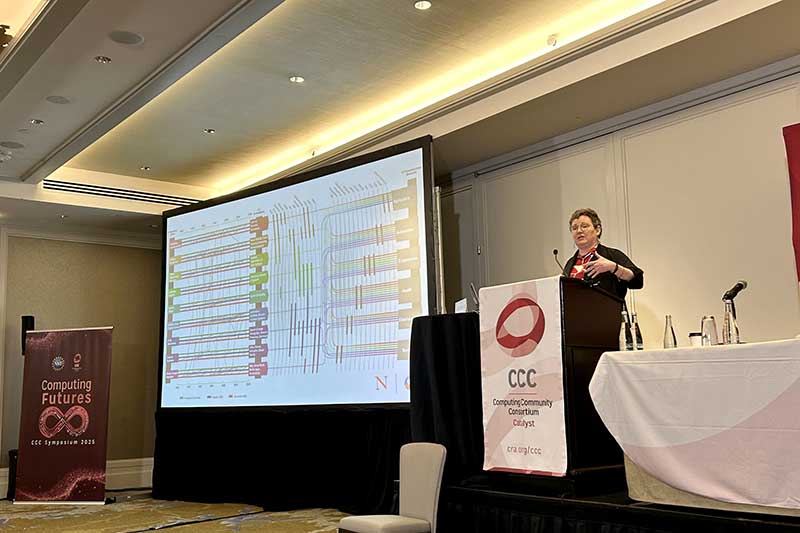Khoury News
Q&A: Khoury Dean Elizabeth Mynatt on federal research funding cuts and what’s next for the US
"We have decades of evidence that federal research funding makes us more knowledgeable and prosperous as a nation. Now is precisely the wrong time to forget that."


Over the last few months, the Trump administration has cancelled billions of dollars in federal research grants and proposed steep funding cuts for the National Science Foundation and the National Institutes of Health. These moves have ignited a fierce debate over the value of federal research funding and the consequences of slashing it.
It’s a debate that Elizabeth Mynatt knows better than most. In 2020, two years before joining Khoury College as dean, she co-chaired the most recent installment of a long-running National Academies report that analyzes IT research, why it requires federal funding, and how it fuels economic growth.
“Past returns on federal investments in IT research have been extraordinary for both US society and the US economy,” she and her colleagues wrote. “Without committing the resources needed to continue fueling IT innovation, the United States risks ceding IT leadership to other nations.”
In the wake of Mynatt’s recent trip to Capitol Hill, where she met with legislators and delivered a plenary talk at the Computing Research Association’s Future Research Symposium, Khoury News sat down with her to discuss the past, present, and future of federal research funding, including what we’ve gained from it and what we would stand to lose without it.
As part of the 2020 National Academies report, you and your colleagues updated the “tire tracks” visualization. What is that, and why does it matter?
“Tire tracks” shows how government funding for university IT research helps create new industries, useful products, and economic growth. It dispels the idea that university research exists in a bubble or that the IT industry is self-sufficient.
I advocated for the 2020 version of “tire tracks” to reflect the impact of IT research across many economic sectors. So much of our research is interdisciplinary and its benefits are not limited to tech companies.

Federal investment in tech research can have exponential payoffs as companies turn academic research results into new products and services. Even when we spend billions of taxpayer dollars each year, we get back much more value than we invest. For example, in 2018, IT industries contributed over $2.2 trillion dollars compared to $5.1 billion for all federal support of IT research and development.
What are some examples of that?
Many of the components in your smartphone, plus the GPS that runs on it. Tools that let automakers design more efficiently while also producing safer and more energy efficient cars. Drones, data analytics, sensors, and self-driving tractors to make agriculture more precise and productive. Improvements in laser eye surgery, cancer care, and diabetes treatment. Better security for credit cards. All done through a combination of federal funding, university IT research, and industry production.
The report also centers on confluence and resurgence. Can you explain the significance of those themes?
Confluence is when IT research innovations combine with domain expertise, design and production knowledge, and new business models to elevate and transform the economy. Examples include health care, the automotive industry, agriculture, even sports — sectors transformed by the integration of IT innovations.
Resurgence is when dormant research is revived by new ideas, researchers, societal circumstances, or innovations in other fields. AI is a classic example, with its “winters” of slow progress followed by today’s breathtaking achievements — all rooted in decades of fundamental research.
The journey from research ideas to tangible results isn’t always fast or direct. It often takes time, resources, and collaboration.
Many of those who support cuts to federal research funding have argued that industry, private philanthropy, and the universities themselves can pick up the slack. Can they?
Not all of it. Not even close.
US economic dominance and quality of life is linked to the US spending far more on research and development than any other country, and federal funding is a critical chunk of that. Industry and university R&D spending are meaningful too, but they can’t make up the gap if government agencies step away. Our worldwide economic and technological leadership stems from sustained federal investments.
Research independence would suffer too. Companies and philanthropists typically prioritize their own interests, so it’s hard to imagine they’d publish research that held their products and practices accountable.
But most critically, companies generally focus on applied research — producing tangible returns as quickly as possible for customers and shareholders. Because universities aren’t beholden to those pressures and because they can play the long game, they are better suited to fundamental research. This is work that lacks immediate applications but will be transformative down the road. Think of number theory planting the seeds for modern cryptography, neural networks enabling today’s powerful AI, or mainframe sharing paving the road to cloud computing. There isn’t always a clear map for great achievement, and we can’t know where undirected research will lead.
Universities can also innovate in ways that companies aren’t incentivized to. For instance, companies might not see a commercial justification in developing assistive devices for people with disabilities. If university research fills that gap, there is immense human benefit, plus the economic benefit of empowering millions of people to work.
Does that mean academic research is more useful?
Not necessarily more useful, but different, and complementary to industry research. Universities, companies, and federal agencies can discover and produce far more together than they could on their own.
Government research grants spur early exploration at universities. Companies apply those findings to real-world problems. Venture capital accelerates promising applications, then commercial success and market growth generate interest in — and resources for — the next cycle of innovation. Innovations compound to create new products and markets.
And critically, academic research is the foundation for training students — the next wave of technology leaders. Many of the “tracks” in our report follow the path of students trained in university labs and courses who then take those insights into industry to create new products and services.
What would it mean for the US if this funding goes away?
Federal research funding has been so central to our national discovery and wealth that it’s hard to envision where we’d be without it. We might not have smartphones, cloud computing, or AI-powered health care tools. Even the internet as we know it — and the entrepreneurship boom it spawned — might not have developed.
For generations, we’ve led the global race for discovery. Slashing our funding would be like slashing our tires for future generations. It would mean fewer innovations and new products. Less nurturing of innovation-hungry students. A weakened economy and national security.
We have decades of evidence that federal research funding makes us more knowledgeable and prosperous as a nation. Now is precisely the wrong time to forget that.

The Khoury Network: Be in the know
Subscribe now to our monthly newsletter for the latest stories and achievements of our students and faculty